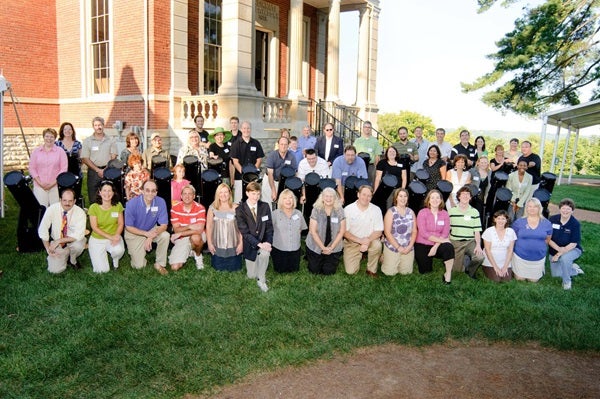Cincinnati Observatory Center’s (COC) 40 Galileos project awarded 40 quality telescopes to individuals and teams who would further astronomy education in the region. All 40 recipients completed the required classes, trainings, and public events prior to the graduation. They had to earn their telescopes, and no one dropped out.
The purpose of the program follows the theme of the International Year of Astronomy — astronomy outreach. Most people in the Cincinnati area have never looked through a telescope. To date, these 40 telescopes have reached more than 7,500 people in Ohio, Kentucky, and Indiana at more than 200 events.
Daphne Horstmeier, a fifth-grade teacher at Cheviot Elementary discovered how few people in her community have looked through a telescope. “None of my 70 students (or their parents) had ever seen Jupiter and its moons through a telescope until I hosted a backyard viewing,” Horstmeier said. “It brought tears to my father’s eyes when he viewed the Moon because he had never seen the amount of detail as he had through this telescope.”
The telescopes definitely make an impact. Mike Kruse, the director of the Batesville Library and 40 Galileos winner, has seen his program as a publicity magnet. “Receiving the telescope was a major event for our library,” Kruse said. “The local newspaper wrote a front-page article, the local radio station did an interview, and the Friends of the Library could hardly wait to purchase some accessories for the scope.”
On any given weekend (and some weekdays), a star party occurs somewhere in the area that one of the 40 Galileos leads. One unexpected benefit of the program is how much the 40 winners collaborate. Recipients launched a blog for the group to exchange ideas and calls for telescopes.
“Wow,” is still the most common reaction, but Bob Schroeder, deacon at St. Antoninus Elementary, witnessed the quintessential sidewalk astronomy moment. At his first public event last May, a young boy, probably 5 or 6 years old, looked at Saturn through the eyepiece without any reaction. He backed up and looked at the front of the telescope tube. “He was looking for a photo of Saturn,” Schroeder said. “Only when he couldn’t find a photo over the end of the tube did he realize that he was actually looking at the planet. His eyes got big, and he got back in line several times to see it again and again.”
That is why we do this. That is why I’m hooked on astronomy education. The universe is accessible to us in so many ways. All we need is a chance to see it, and, in Cincinnati, a new population of observers forms. Schroeder stated, “The public observing sessions have helped to build community, not only within our school, but within our church and, to a smaller degree, within our neighborhood.” As someone who has been welcomed into astronomy organizations, I’m happy to see this revolve around 40 telescopes.
At the graduation ceremony, astronomy historian Owen Gingerich was our special guest. He shared a tale of his early public star parties. He was working at an outreach event for his university when he met a charming young lady under the stars (whom he eventually married). Gingerich omitted all details and concluded abruptly and in a perfect deadpan voice, “And that is what outreach can do for you.”
We could not have done this without the support of Astronomy magazine. Before winning its 2008 Out-of-this-World Astronomy Award, I wasn’t sure this idea would ever get off the ground. It was a bold and expensive dream, but the award helped to legitimize the project that brought in volunteers and donors. Building this program around impressive instruments drew support and a superb crew of Galileos. It is a project that is easily repeatable in any community, and I’d be glad to share my experiences with others.
We are proud to announce that the project is far from over. NASA has chosen to fund a Cincinnati Observatory proposal to continue supporting the 40 Galileos and awarding an additional 20 telescopes in each of the next 3 years. By 2012, there will be 100 quality telescopes in the region — making Cincinnati “Telescope Town.”
Dean Regas is the Outreach Astronomer at the Cincinnati Observatory Center. He can be reached at deanobservatory@zoomtown.com and writes an astronomy/mythology blog.












